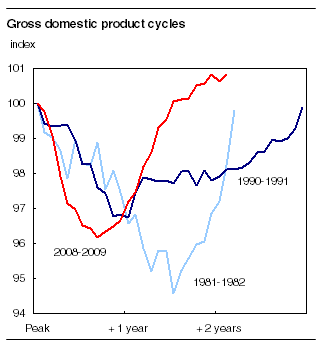Study: Comparing the 2008-2010 recession and recovery with previous cycles
Archived Content
Information identified as archived is provided for reference, research or recordkeeping purposes. It is not subject to the Government of Canada Web Standards and has not been altered or updated since it was archived. Please "contact us" to request a format other than those available.
Related subjects
-
[an error occurred while processing this directive]
By most conventional measures (real gross domestic product, employment or hours worked) the 2008-2009 recession in Canada was less severe than those in 1981-1982 and 1990-1992.
However, this outcome does not capture the significant impacts stemming from the global financial crisis. Indeed, both output and employment in the early stages of the downturn contracted at the fastest rate of any post-war recession.
Mostly, this reflected the unprecedented decline in global trade flows and the resulting quick and severe drop in corporate incomes and spending.
The economy began to stabilize in mid-2009 in response to policy measures in Canada and abroad.
As a result, the decline in output in Canada, although significant, was less pronounced than in other major industrialized countries, and the subsequent recovery quicker and more complete, with Canada the only G7 nation where real output, private domestic demand, and employment have returned to pre-recession levels.
Output and employment
In terms of output, the contraction that occurred during 1981-1982 had the largest peak-to-trough decline. But it was uneven, with several months of growth interspersed in a steep downward trend, followed in 1983 by the sharpest recovery of the three cycles.
The 2008-2009 downturn was not as deep overall as the 1981-1982 recession. Nevertheless, it set a post-war record for the most months (eight) of uninterrupted decline, a testament to the severity of the onset of the global economic and financial crisis.
The different speeds of recovery show why it is difficult to state categorically that one recession is more severe than another. While the peak-to-trough declines in real gross domestic product were larger in 1981-1982 and in 2008-2009, the lingering nature of the weakness in 1990-1992 implies that more output was lost relative to zero or potential growth during that recession.
Note to readers
This release is based on a feature article in the January 2011 edition of Canadian Economic Observer that compares the 2008-2009 recession and recovery with those in 1981-1982 and 1990-1992. The article also points out some basics of how Statistics Canada determines whether an economy is in recession.
By any measure, the 2008-2009 recession was less severe for employment. The job loss was smaller and the economy recouped its losses more quickly than during the other two cycles. The recovery in 2009-2010 was almost over in the same amount of time as it took for the recession to hit bottom in 1982 and well before the trough in 1992.

Sectoral demand: Exports, investment, household spending
The most striking feature of the 2008-2009 recession was the speed and severity of the contraction in exports. Export earnings plunged 30% in less than six months, and ultimately fell nearly 40% before export growth resumed. This compares with a drop of about 10% for exports during the recessions that started in 1981 and 1990.
Lower business investment in plant and equipment is one of the hallmarks of severe recessions. Business investment fell by about 20% in volume in the 2008-2009 recession. This matched the total decline in business investment recorded during the recessions starting in 1981 and 1990.
However, the 20% reduction starting in 1990 occurred over three years, while for 1981-1982 it was spread out over two years. Firms matched these total cuts in just three quarters in late 2008 and in early 2009.
In 2010, business investment accelerated and led growth in the second and third quarters of the year. However, investment remains well below its pre-recession level, recovering only half its losses during the downturn.
Despite exports and business investment recovering less than half their declines, overall demand has recouped its recession losses. This was largely a result of the strong recovery of household spending (defined as the sum of personal expenditure and residential construction).
In both the recessions starting in 1981 and 1990, household spending contracted by nearly 6%, bottoming out about one year after each recession began.
In 1981-1982, it took household demand two and a half years to regain its pre-recession level. After the 1990-1991 recession, it took households four full years to return to their pre-recession level of spending.
In contrast, household demand fell by only 2% over two quarters during the last recession. With a recovery starting in the second half of 2009, this loss was essentially recouped by the first anniversary of the onset of the crisis.

Definitions, data sources and methods: survey numbers, including related surveys, 1901, 2202 and 3701.
The study, "How did the 2008-2010 recession and recovery compare with previous cycles?" is included in the January 2011 Internet edition of the Canadian Economic Observer, Vol. 24, no. 1 (11-010-X, free), now available from the Key resource module of our website under Publications.
For more information, or to enquire about the concepts, methods or data quality of this release, contact Philip Cross (613-951-9162; ceo@statcan.gc.ca), Current Economic Analysis Group.
- Date modified:
